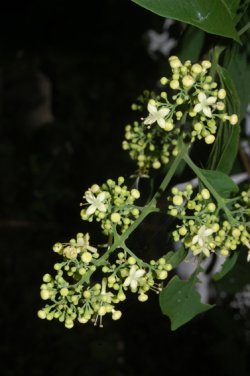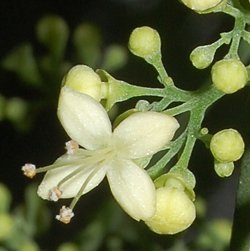 |
QUICK SEARCH
MO PROJECTS:
Africa
Asia/Pacific
Mesoamerica
North America
South America
General Taxonomy
Photo Essays
Training in Latin
America
MO RESEARCH:
Wm. L. Brown Center
Bryology
GIS
Graduate Studies
Research Experiences
for Undergraduates
Imaging Lab
Library
MBG Press
Publications
Climate Change
Catalog Fossil Plants
MO DATABASES:
W³MOST
Image Index
Rare Books
Angiosperm
Phylogeny
Res Botanica
All Databases
INFORMATION:
What's New?
People at MO
Visitor's Guide
Herbarium
Jobs & Fellowships
Symposium
Research Links
Site Map
Search
|
Draft Treatments | Guidelines | Checklist | Citing | Editors The Cutting EdgeVolume XVII, Number 4, October 2010News and Notes | Leaps and Bounds | Germane Literature | Season's Pick | Annotate your copy This season, the nod goes to the mundane Aegiphila panamensis Moldenke (Lamiaceae; to be treated in Verbenaceae in the Manual).
Although lacking particularly showy flowers, this sp. nevertheless has its story to tell. Like this one, all Aegiphila spp. from Costa Rica (except A. costaricensis Moldenke) are heterostylous: some plants, as in the photos above, have exserted stamens and included styles, while others have the styles long-exserted and the stamens hidden in the tube. After careful examination of herbarium material, we would go one step further: we believe the plants are dioecious. Flowers (specimens) as in the photos have pollen in the anthers, and are never associated with fruiting material, whereas long-styled flowers have only sterile anthers and can be found on material with young fruits. Additionally, at least in this sp., plants with staminate flowers seem to be more common (or more commonly collected) than those with pistillate flowers; of ca. 20 flowering specimens found at INB, only four had pistillate flowers, and the three plants examined in the area of the above photo (several hundred meters distant from one another) were all staminate. This is our lame excuse for not having photos of the pistillate morph! |
||||||
© 1995-2025 Missouri Botanical Garden, All Rights Reserved
4344 Shaw Blvd.
St. Louis, MO 63110
(314) 577-5100
Technical Support

